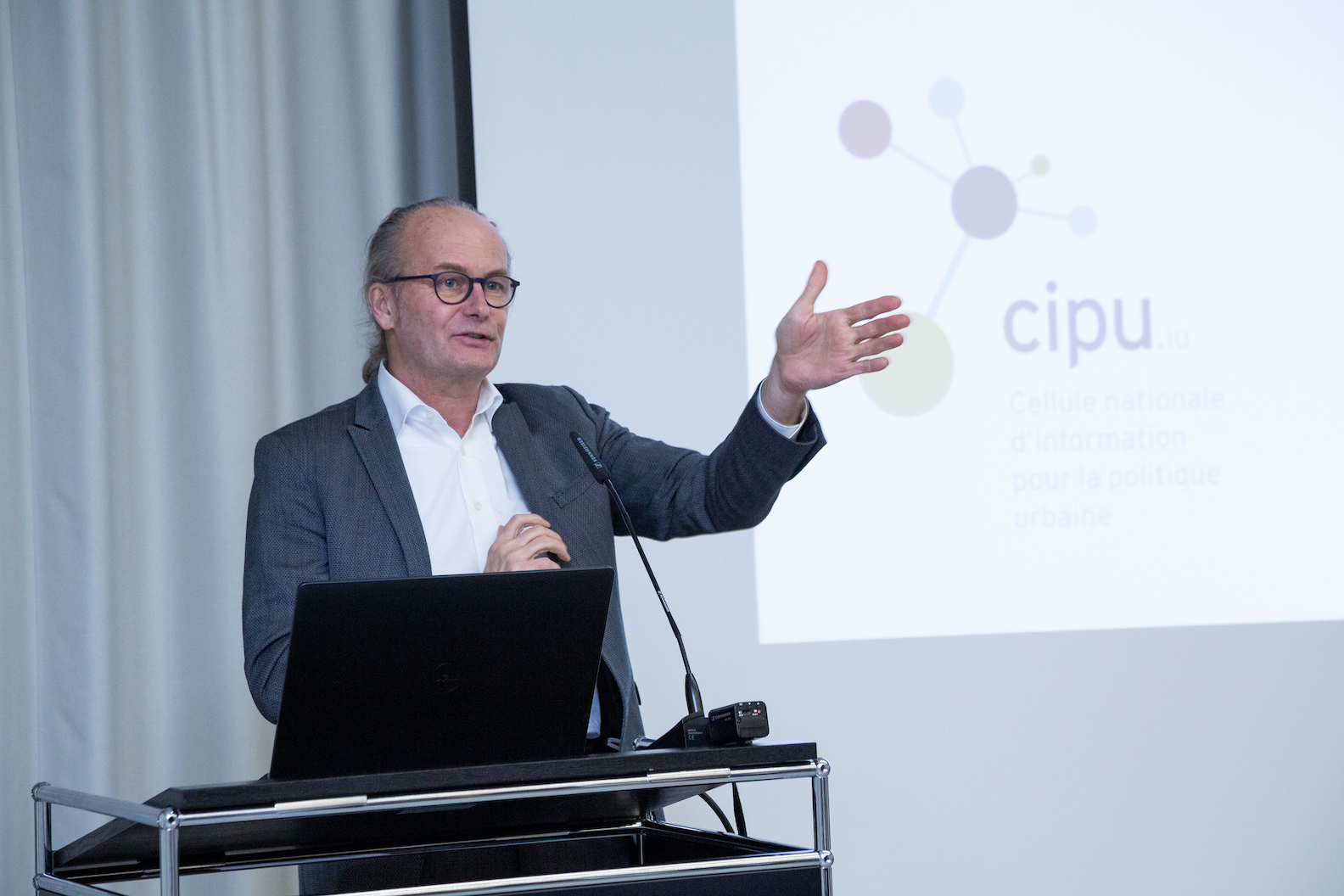Late 2020, we interviewed Ms Lydie Polfer, Mayor of Luxembourg City on the role and potential of climate change adaptation in urban planning and municipal development. The interview also addressed questions on climate action in the capital of the Grand Duchy of Luxembourg.
Interviewer: Ms Polfer, measures addressing climate change can be for climate action, such as measures decreasing hazardous emissions, or for adaptation, so measures dealing with the consequences of climate change. What role does urban and district development play in adapting to climate change?
Mayor Polfer: Climate change adaptation and also climate action are key aspects that need to be considered together when planning in urban areas. On the one hand, climate actions reduce emissions of inhabitants and businesses in a district. On the other hand, climate change adaptation helps to protects inhabitants from natural hazards resulting from climate change.
There is a wide range of possible measures for climate action in the urban environment. For example, in Luxembourg City, we focus on reducing the need for transport by creating functional mixtures in the urban pattern. We adopt circular economy approaches, enabling building material to be reused and recycled in urban construction and we favour net-zero-energy buildings. These measures all have a positive impact on the energy footprint. To reduce this footprint, sustainable transport is also important. Just to give an example, Luxembourg City is a frontrunner in electric public mobility and about 30 % of the city busses are electric as of today in 2020.
For climate change adaptation, we focus on renaturalised rivers and waterways to increase absorption of rainwater in urban areas. We test technical measures for rainwater retention in ponds or temporary reservoirs and we try to limit the amount of soil sealed in existing and newly built-up urban areas. The guiding documents for our city to address climate action and climate change adaptation are the Municipal Environmental Report and Action Plans. These annual reports and plans orient Luxembourg City measures. They help us to work towards a good and secure urban life, and an urban life in line with sustainability objectives.
Interviewer: Where do you see priorities or opportunities to use existing or new spatial planning and urban development instruments for climate change adaptation in Luxembourg?
Mayor Polfer: The City of Luxembourg uses three complementary planning instruments for climate change adaptation. The land-use plan, so-called PAG, the special development plan, the PAP, and the Municipal Building Regulation, defining requirements and technical specifications for buildings and infrastructure.
The PAG is used for zoning areas and defines density requirements and limitations to soil sealing. With the PAP and the Municipal Building Regulation, the municipality uses two more nuanced instruments. These enable our municipal planners to take decisions on the future layout of areas and the location, orientation and shape of buildings. They also detail surfaces to be kept unsealed, and even define materials to be used. Also, we look to optimise the number of parking spaces to keep areas open that are usually sealed. This way, we integrate various elements in our plans to ensure that transformations and new developments are adapted to climate change. And of course, for climate action, these tools work equally well.
We conduct many experiments in urban planning practices and we research experimental building techniques. This leads to a high number of innovations in the building sector, especially in view of climate change. An example is the use of grey water, or rainwater in large residential buildings or greening roofs, for which new concepts are being tested. To benefit from the latest innovations, we need measures that allow us to design the district differently. Faster procedures and increased openness of projects towards new insights and concepts on climate action and adaptation in planning is required.
Interviewer: What potential for climate change adaption is there from converting urban brownfields?
Mayor Polfer: In conversion or re-conversion projects, for example ‘Porte de Hollerich’ or the 10 hectare area of ‘Josy-Barthel’, planners have a free hand. When we develop a district from scratch, we face fewer limitations. We also need to compromise less when it comes to implementing climate change adaptation measures. For example, a river can take its natural course again, an inundation area can fulfil its initial function. It also provides us with unique opportunities to design park areas as both zones helping to adapt the city to climate change and also as recreation areas for inhabitants of the districts.
Planning on unbuilt land also allows us to develop a priori climate change adaptation and action concepts that guide urban design and the layout. This way, the best option, yielding the best protection or adaptation can be planned and tested before being realised. We look at such concepts not just at the neighbourhood level but also for the district. Hence these new urban developments are key to increasing the resilience of our city, as changes to existing urban districts are limited for various reasons.
However, the question of ownership significantly influences climate change adaptation measures in such urban projects. Unless all land is owned by the City of Luxembourg, we rely on a consensus between all owners on what climate change adaptation measures will be implemented. If an owner does not approve, the procedure is postponed, or the plans have to be amended, compromising on the planned adaptation measures.
Interviewer: How can one combine the persistently high pressure on the housing market with measures of climate change adaptation, in your opinion?
Mayor Polfer: High pressure on the housing market and climate change adaption are not mutually exclusive. In a way, planning in cities is already an adaptation and a climate action measure. Let’s take the example of the City of Luxembourg. Luxembourg City accounts for about 2 % of the national territory and of this 2 % half are green areas, so forests, grassland, pastures or farmland. At the same time, about 20 % of the country’s population lives on the other 1 % and about 40 % of the national workplaces are located in the City of Luxembourg.
This results in density that offers proximity to daily activities such as workplaces or grocery shops, for inhabitants, reducing the need for transport. This helps us to offer much more targeted and effective measures.
The City of Luxembourg population has increased by more than 30 % during the past 10 years. This very high pressure is a challenge to urban planning in many ways. Increasing traffic, increasing pressure on the housing market, increasing pressure on public services, and so on. But despite this pressure, we have managed to make progress in achieving our environmental objectives, defined in the Municipal Environmental Report and Action Plans. This applies to the climate action measures, so to lower energy consumption or less municipal waste. This also applies to the adaptation measures, including the implementation of natural water retention systems or unsealing soil.
Of course, this does not come easily: when planning urban districts, we integrate environmental aspects in the conception plans from the very beginning. Therefore, it is important that the objectives and measures are clearly defined. This way, urban development and other urban functions can incorporate and work on environmental protection and climate change adaptation.

Interviewer: What is the role of the CIPU for climate change adaptation in Luxembourg?
Mayor Polfer: Urban development and planning is a complex and interrelated matter. When we develop plans, we usually touch on a variety of inter-connected disciplines, requiring us to work with various constrains and limitations. Sometimes urban planning meets disapproval from inhabitants and experts in related fields. Climate action and adaptation measures especially require planners to plan in a way that does not appear logical to the outside viewer.
CIPU should enhance mutual understanding and coordination between different policy fields, between planners and also between planners and inhabitants. This way, CIPU could be a mediator in the framework of urban development and for this year, focusing on climate change adaptation.
Interviewer: Thank you very much Mayor Polfer for the interview.
In case of questions or comments, please feel free to contact the editor (sebastian.hans@spatialforesight.eu) of this article.



